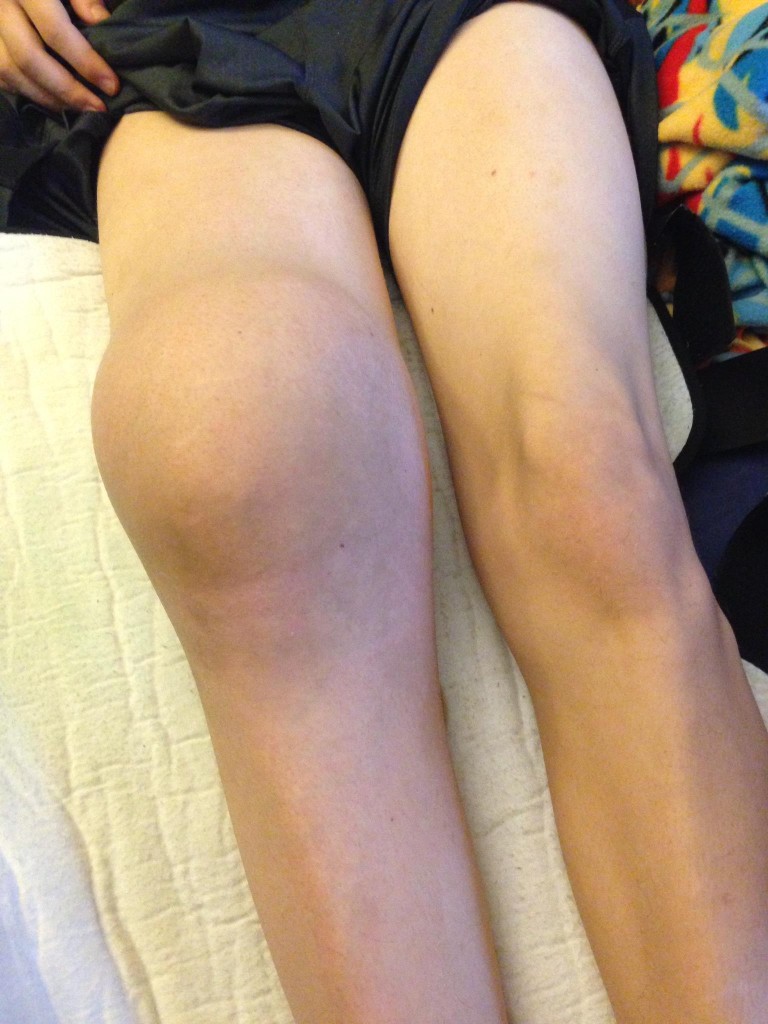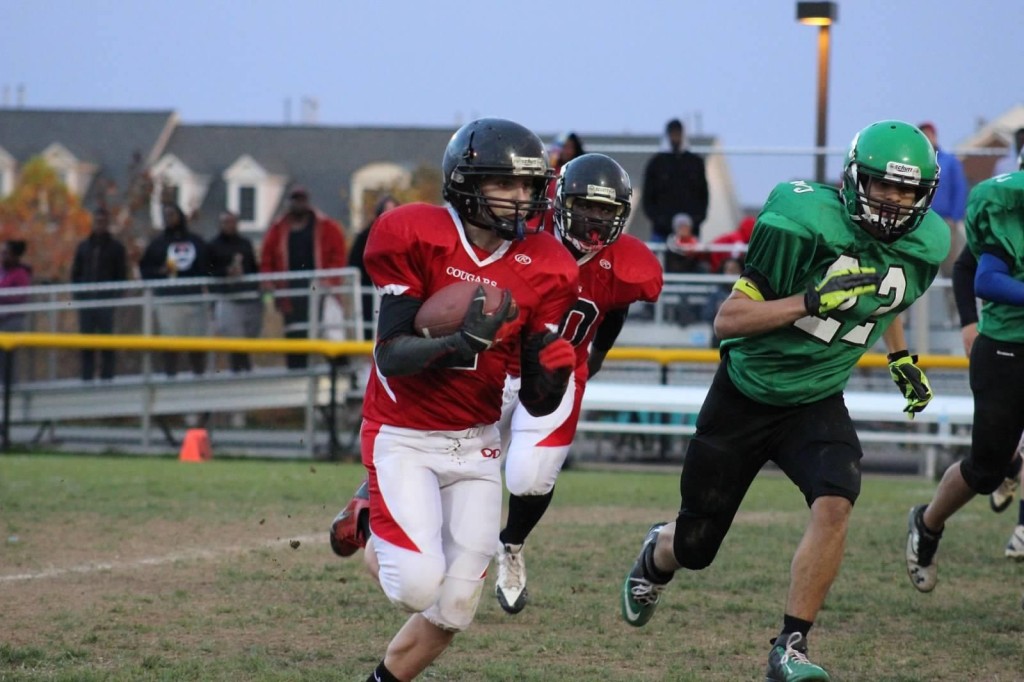WASHINGTON — The first thing that strikes you when talking to Austin Cohen is his presence. At 14, most of us are awkward and self-conscious, either withdrawing in our shyness or brashly overcompensating for it. It’s even rare to encounter an adult so immediately straightforward and honest — who looks you in the eye without anxiety while discussing their hopes, their dreams and their half-missing leg.
Let’s back up. A year ago, Austin was a pretty normal eighth grader, an athletic kid who began to come into his own as he discovered success on the football field. He emerged as the starting running back on his eighth-grade team and looked forward to playing in high school at Gaithersburg, Maryland’s Quince Orchard.
One day last winter, he started feeling a pain in his leg. Austin’s father, Scott, was concerned when his son mentioned it — his son wasn’t normally one to complain — but not overly so. Scott chalked it up to growing pains at first, but when the pain didn’t subside within a week, they went to get help. An osteopathic doctor figured Austin’s hips were out of alignment. The prescribed remedy: stretch it, ice it, go home.
But the pain persisted. Scott took Austin to another doctor for a second opinion. They did an X-ray. Something was off. Not wanting to worry his wife and Austin’s mom, Miriam, Scott tried to keep the news to himself until they could get more information. His efforts were in vain.
“So my phone rings at work and I see I have a voicemail,” Miriam recalls. “And I call my pediatrician back, and they told me that Austin was referred to an oncologist. And I said, ‘No, no, you’re mistaken, he was referred to an orthopedist.’”
She asked the office to confirm Austin’s birth date, thinking they must have mixed his file up with another patient. Surely her athletic, healthy teenage son wasn’t going to see an oncologist. Oncology means cancer.
Cancer was nothing new to the Cohens — it had plagued Miriam’s father, Mark, at several points in his life. He succumbed to his last bout of throat cancer in December 2013, just a few months before the family was confronted with Austin’s developing illness.
That illness turned out to be an osteosarcoma, or bone cancer, a condition that affects only a few hundred people per year in the United States, many of them children. It’s so rare you simply couldn’t imagine it ever happening to your kid, even if you knew what it was.
“It’s the worst thing in your life,” says Miriam. “That’s all I can say.”
The night before the biopsy, Austin came into his parents’ bedroom feeling ill. He passed out and collapsed. After the diagnosis, but before the surgery, Austin’s leg had weakened to the point where it gave out and broke underneath him.
By the time they got him ready for surgery, the area around his knee had swollen to the size of a cantaloupe. But the decision of how to remove the mass was not a simple one. Under the duress and stress of coping with the immediate illness, there was the matter of thinking about the future, of how a still-growing, active boy was going to live the rest of his life without a normally operating leg.

There were two traditional options, neither of them pretty. Austin could undergo a limb salvage, where the tumor is removed and a titanium bone is put in place. It is a heavy-duty surgery, and often needs to be repeated in the future as bone structure changes and adjusts.
Or he could have his leg amputated above the knee.
Not content with either scenario, the Cohens kept looking. They were introduced to a radical surgery called rotationplasty. It sounds insane at first, especially to the squeamish.
“You’re cutting out literally everything,” explains Dr. Carol Morris, orthopedic surgeon at Johns Hopkins, and she isn’t exaggerating. “From the middle of the thigh to the middle of the shin bone, including all the skin, all the muscle, all the bone, the entire joint. But you’re leaving the nerves and the blood vessels down to the foot.”
Then comes the part that defies logic. Over the course of the six- to eight-hour surgery, the ankle and foot are turned 180 degrees and attached above the knee joint, nerves and blood vessels intact. The ankle becomes the new knee — heel out, toes up, pointed underneath. Visually, it laughs in the face of conventional wisdom, and the brain struggles to comprehend how it could possibly be beneficial, until you see it work.
Morris understands. “To tell a parent ‘I’m going to turn your child’s leg backwards’ is daunting, at best,” she says.
Take all the awkwardness you remember from being 14, a freshman in high school, and imagine trying to survive the social gauntlet with half your leg missing and your foot attached backwards. Oh — and try doing it without your hair, lost long ago in the 20-some-odd rounds of chemotherapy.
“At first the rotationplasty sounded really crazy,” says Austin. “It just sounded so weird to me. Like, having my foot be backwards? I didn’t really want to get that.”
But in spite of the circumstances, and despite his young age, Austin was able to see the long view. He couldn’t imagine a life without physical activity, one that the limb salvage would make nearly impossible. He had to be able to run again, to jump again. To be a kid again.
“He really was able to, in a way that I’ve not seen with other kids his age, look towards the future,” says Dr. Morris. “I think other patients, teenage boys, would say ‘I don’t want a surgery that’s going to make me look different.’”
While both Miriam and Scott also believed the rotationplasty would give their son his best chance at a normal life, they left the final say to Austin. Independently, he came to the same conclusion.
“Throughout this whole treatment, he has been more of an adult than a child,” says Miriam. “He’ll be the first one to tell you he came to this decision on his own.”
Of course, simply deciding on the best course of action was only the beginning. Life doesn’t stop just because your life takes an unexpected turn. For the Cohens, on top of taking care of Austin there was still the daily grind of work, not to mention the responsibility of caring for his younger sister, Courtney. With Miriam managing Austin’s care and Scott doing his best to juggle the rest, the community came together to support the family in a way the Cohens never expected.
Friends held a buzz-cutting party and shaved their heads in solidarity. Numerous fundraisers were set up to help with medical expenses. Three nights a week, families would cook dinner for the Cohens and deliver it to their house.
“We had a lot of friends in the community, that we knew and that we didn’t know, and I felt like they really put their arms around our house and just held us tight,” says Miriam.
Even as everyone made Austin the center of their love and attention, he remained cognizant of the efforts made not only on his behalf, but for his family. He remembered all of the little things — the one nurse with the British accent, who stayed up with him for two hours to make sure he was able to swallow medication when his throat was sore and swollen. The nice things they did not only for him, but for his mom, making her as comfortable as possible in her unchosen home away from home.
Meanwhile, the Quince Orchard football team did their part to make sure Austin didn’t lose contact with his teammates. Even though he had yet to even become a part of the football team, Austin was embraced and given the position of team photographer for JV, patrolling the sidelines on crutches in his jersey on game day. He was even granted the opportunity to shoot some of the varsity games. Austin grabbed his new responsibility and ran with it, attending every game he could, when not at the hospital.
For Miriam, the transition was harder. She didn’t want to go sit in the stands with the other parents and face the inevitable questions about why her son was on the sideline while his friends played. But Austin dragged her along, and the experience was eye-opening, in terms of how she viewed both her community and her son.
“The one thought that came to me was so proud of him I was that he wasn’t upset about not playing,” she recalls. “That was another time he taught me something. … It’s funny when your kids teach you, right?”
At the end of every home game he attends, Austin lays down on the QO logo in the middle of the football field, staring up at the night sky, waiting for the day he will be able to step off the sidelines and play again. That dream may seem far-fetched, given his circumstances, but Austin’s doctors believe he can make a full recovery and play sports at the college level.
“You can do anything on it,” says Morris. “You can play varsity sports; you can run a marathon. The worst thing that happens is you break your prosthetic leg. Then you go and you get a new prosthetic leg.”

Dr. Holly J. Meany, who is supervising Austin’s care at Children’s National Medical Center, says cases like Austin’s have about a 70 to 75 percent cure rate, as long as the disease was localized, as his was. And she has already seen great progress since his rotationplasty, the first such surgery she can remember at Children’s.
“He’s already showing how well he’s adjusted to the surgery and his new prosthesis,” says Meany.
Of course, there’s always the chance the cancer could come back, or that the surgery and chemotherapy did not catch everything. Austin will have scans every three months for the first couple years to check, then every six months for the first five years.
As the healing process began, Scott started an email listserv for friends and family who wanted updates on Austin’s progress, not knowing what the response would be. More than 150 people signed up.
“For me, it was a way to keep people informed,” he says. “But it was also cathartic.”
The biggest emotional purge came in early December, when Scott was able to send out the news he has been hoping for since this entire ordeal began. There was no need to dress it up with 10-dollar words or long explanations. When you’ve stared your worst fears in the face and survived, you don’t worry about colorful language.
MRI: clean. Bone scan: clean. X-ray: clean. Peace out.
It doesn’t mean Austin’s totally out of the woods, but does mean he can start looking forward. By his last round of chemo, he already knows the process: the urine test. The blood pressure measurements every 15 minutes for the first hour. He’s done talking about that. He wants to talk about what’s next.
He wants to go to Japan. Get better at photography. Finish high school. Go to college. But he’s got even bigger physical goals.
“I’d like to run a marathon with my prosthetic leg,” he says.
Of course, Austin knows exactly what that challenge means, and how long and arduous the path in front of him is.
“I have to learn how to run, and walk without crutches first.”
And he also wants to return to football, to his friends and teammates. They’ve been his family away from his family throughout this process, and he can’t imagine being anywhere other than on the field next year.
“Basically, the whole entire school knows about me wanting to play football next year,” he laughs. “Even if I can’t get that much playing time, still, just to be on the team with all my friends and all the guys, it’ll be great.”
It’s that upbeat approach that makes Austin so magnetic, that draws such praise from his family and his doctors in handling an unimaginable challenge.
“If I didn’t have a positive attitude, they would think there is something wrong,” he says. “Really, there’s nothing wrong. I just have kind of a limp.”
Special thanks to Lindsay Simpson and Brandon Mowry from Monumental Sports for their work on this story.
Follow @WTOP and @WTOPSports on Twitter and WTOP on Facebook.






